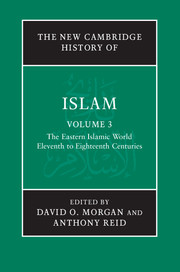Book contents
- Frontmatter
- Introduction: Islam in a plural Asia
- PART I THE IMPACT OF THE STEPPE PEOPLES
- PART II THE GUNPOWDER EMPIRES
- PART III THE MARITIME OECUMENE
- PART IV THEMES
- 15 Conversion to Islam
- 16 Armies and their economic basis in Iran and the surrounding lands, c. 1000–1500
- 17 Commercial structures
- 18 Transmitters of authority and ideas across cultural boundaries, eleventh to eighteenth centuries
- Glossary
- Bibliography
- Index
- References
17 - Commercial structures
from PART IV - THEMES
Published online by Cambridge University Press: 28 March 2011
- Frontmatter
- Introduction: Islam in a plural Asia
- PART I THE IMPACT OF THE STEPPE PEOPLES
- PART II THE GUNPOWDER EMPIRES
- PART III THE MARITIME OECUMENE
- PART IV THEMES
- 15 Conversion to Islam
- 16 Armies and their economic basis in Iran and the surrounding lands, c. 1000–1500
- 17 Commercial structures
- 18 Transmitters of authority and ideas across cultural boundaries, eleventh to eighteenth centuries
- Glossary
- Bibliography
- Index
- References
Summary
From ancient times, the eastward movement of precious metals in exchange for merchandise has been a defining feature of the commercial structure of the eastern Islamic world. Sources suggest that this pattern was well established already in the first century of the Common Era, and that it continued even into the nineteenth century. For example, in his Natural History, the Roman author and adviser to the emperor Vespasian (r. 69–79), Pliny the Elder (23–79), complained that ‘in no year does India drain our empire of less than five hundred and fifty millions of sesterces, giving back her own wares in exchange, which are sold among us at fully one hundred times their prime cost’. Pliny may have been guilty of exaggerating the effluence of Roman specie to India for effect, but his assertion nevertheless suggests that Rome suffered a substantial deficit in its eastward trade. Also writing in the first century, the anonymous author of a handbook for Roman travellers in the Indian Ocean indicated that much Roman specie was exchanged for Indian textiles, available in abundance in the port of Baryagaza, in modern Gujarat.
Numerous accounts report a similar pattern of trade in the early modern era. Focusing on the growing European trade with Mughal India in the seventeenth century, the Italian physician Niccolao Manucci (1639–1717) observed that the Indian export commodities in greatest demand at the time – cotton textiles, indigo, opium and silk – were all agricultural in nature.
- Type
- Chapter
- Information
- The New Cambridge History of Islam , pp. 561 - 581Publisher: Cambridge University PressPrint publication year: 2010
References
- 2
- Cited by



